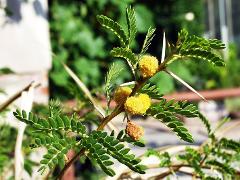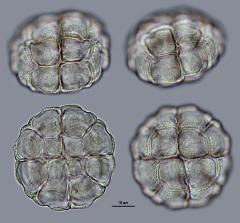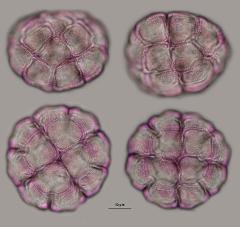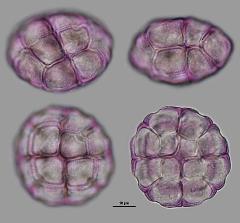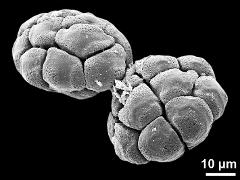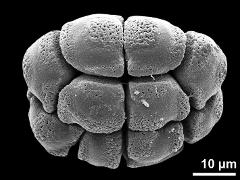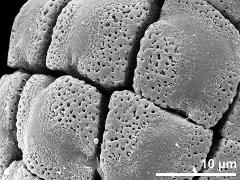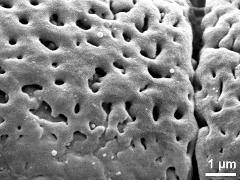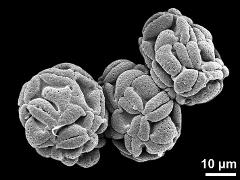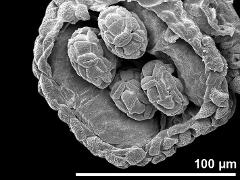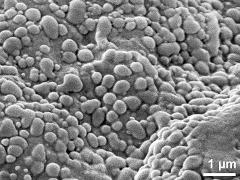Acacia karroo
Taxonomy: Angiospermae, Fabales, Fabaceae, Acacia
Published: 2021-03-24
Pollen Description
Shape, Size and Aperture
pollen unit: polyad, dispersal unit and peculiarities: polyad, size (pollen unit): medium-sized (26-50 µm), size of hydrated pollen (LM): 41-50 µm, shortest polar axis in equatorial view (LM): 31-35 µm, longest polar axis in equatorial view (LM): 41-50 µm, shortest diameter in equatorial or polar view (LM): 41-50 µm, longest diameter in equatorial or polar view (LM): 41-50 µm, pollen class: polyad, polarity: heteropolar, P/E-ratio: -, shape: -, outline in polar view: -, dominant orientation (LM): oblique, P/E-ratio (dry pollen): -, shape (dry pollen): irregular, outline in polar view (dry pollen): irregular, infoldings (dry pollen): irregularly infolded, aperture number: none, aperture type: no aperture, aperture condition: -, aperture peculiarities: -
Ornamentation and Structure
LM ornamentation LM: scabrate, gemmate, verrucate, nexine: -, sexine: -, SEM ornamentation SEM: perforate, suprasculpture SEM: -, TEM tectum: -, infratectum: -, foot layer: -, endexine: -, intine: -, wall peculiarities: tenuitas, supratectal element: -
Miscellaneous
pollen coatings: -, reserves in cytoplasm: -, cell number: -, Ubisch bodies: present
Annotations: apertural condition not clear, distal tenuitas (colpus-like)
Author(s) of diagnosis: Halbritter, Heidemarie; Heigl, Helmut
Pictures
Picture legend
- flower(s), photographer: Halbritter, H.
- hydrated pollen - fresh, glycerine, unstained, photographer: Heigl, H.
- hydrated pollen - fresh, glycerine, ruthenium red, photographer: Heigl, H.
- hydrated pollen - fresh, glycerine, ruthenium red, photographer: Heigl, H.
- hydrated polyads - fresh, rehydrated (water) & critical point dried & sputter coated with gold, photographer: Halbritter, H.
- polyad - fresh, rehydrated (water) & critical point dried & sputter coated with gold, photographer: Halbritter, H.
- detail of exine surface - fresh, rehydrated (water) & critical point dried & sputter coated with gold, photographer: Halbritter, H.
- exine surface - fresh, rehydrated (water) & critical point dried & sputter coated with gold, photographer: Halbritter, H.
- dry polyads - dry, sputter coated with gold, photographer: Halbritter, H.
- anther with 4 polyads - fresh, rehydrated (water) & critical point dried & sputter coated with gold, photographer: Halbritter, H.
- Ubisch bodies on inner anther wall - fresh, rehydrated (water) & critical point dried & sputter coated with gold, photographer: Halbritter, H.
Literature
- (1998) Preparing living pollen material for scanning electron microscopy using 2,2-dimethoxypropane (DMP) and criticalpoint drying. Biotechnic Histochem 73: 137–143
Copyright and Citation
Cite this publication as:
Halbritter H., Heigl H. 2021. Acacia karroo. In: PalDat - A palynological database. https://www.paldat.org/pub/Acacia_karroo/305601; accessed 2024-11-01

